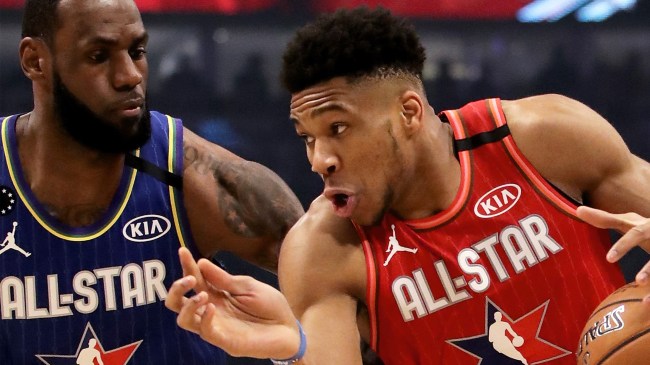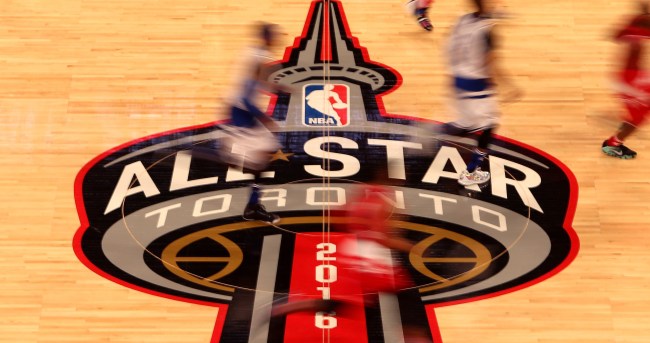
Getty Image
Last week, the NBA hosted its annual All-Star Weekend in Salt Lake City over the course of a gathering that saw the man, myth, and legend who is Mac McClung breathe some new life into the Slam Dunk Contest with a performance that gave Spud Webb’s unlikely win a run for its money.
The following day, Team LeBron and Team Giannis faced off in what was supposed to be the weekend’s premier event. While the NBA’s All-Star showdown has always been a glorified pickup game, 2023’s installment was a particularly underwhelming one that attracted a ton of scrutiny from players, fans, and coaches.
Earlier this week, we learned that the lackluster contest had generated equally lackluster television ratings, as the 4.59 million viewers who tuned into TNT and TBS to watch it marked a historic low for a league that has repeatedly attempted to up the level of intrigue.
That led to plenty of people wondering how the NBA can turn the All-Star Game around and generate some renewed interest going forward.
However, when you combine recent history with current trends and some sobering realities, it may be time to admit there’s no real use in devoting a ton of time and resources to attempting to revive a game that is unlikely to come off of life support no matter how hard the NBA tries.
Why the NBA All-Star game (and All-Star Games in general) might be a lost cause

Getty Image
Some traditionalists would argue the biggest issue with the current state of the NBA All-Star Game stems from the fact that the league tried to fix something that wasn’t broken in the first place.
However, it’s not a coincidence changes were introduced as TV ratings started a slow but steady decline following a 2011 contest that attracted 9.1 million viewers (which was still a far cry from the 16 million the All-Star Game averaged in the 1990s).
2018 marked the beginning of a new era that saw the NBA replace the traditional Eastern Conference vs. Western Conference format with the formula that has seen two designated captains draft their rosters ahead of the game.
The league also increased the prize money up for grabs that year, as the players who’d previously received $50,000 for winning got some extra incentive to secure the W after that number rose to $100,000 (members of the losing team saw their $25,000 check remain the same).
There was no major boost in ratings that year, and while the introduction of the “target score” in 2020 may have resulted in a minor uptick in viewership, the NBA was unable to keep that momentum going before seeing things really crater this season.
When you consider none of those tweaks managed to have the desired effect, there’s a need to look at some of the more glaring fundamental issues that may never be adequately addressed.
As mentioned above, the NBA has attempted to up the financial incentive. However, the nature of the All-Star Game means it’s going to attract the best players in the league, and the vast majority of them already have massive contracts to match their level of talent.
As a result, it’s hard to imagine there’s any sum that’s going to motivate them to leave it all on the floor for the sake of the fans.
After all, the upsides of exerting a ton of effort are wildly outbalanced by the downsides of being injured due to overdoing it; it’s easy to understand why the NBA wanted Joel Embiid to play this year despite the injury he was dealing with, but it’s pretty hard to blame him for not wanting to risk making it worse during what amounts to an exhibition game.
At the risk of getting too into the weeds when it comes to discussing media consumption in our current day and age, it’s also hard to ignore how the constantly evolving entertainment landscape has contributed to a decline in interest from a fan perspective.
Every sport has had to grapple with the fact there’s much less incentive to set aside your time to watch a game when you can consume the highlights on social media, but you also can’t overlook the type of fan that has traditionally been drawn to the All-Star Game when it comes to explaining the dropoff.
I admit I was unable to find a definitive breakdown of viewing demographics over time, but I think it’s pretty common knowledge that the NBA (as well as every other league) has traditionally relied on younger viewers who are interested in watching the best athletes do their thing as opposed to older fans with less time on their hands and who are more apathetic about that particular aspect.
That brings us to the existential threat sports leagues have found themselves grappling with in recent years. It would be hyperbolic to suggest “GEN Z IS KILLING SPORTS,” but there’s growing data that shows members of that generation just aren’t as interested in that particular form of entertainment as their elders have been.
Again, it’s difficult to quantify just how large of a role that factor has played when it comes to the decline in ratings for the NBA All-Star Game, but it’s certainly not helping the situation and will likely help to make the current woes even worse in the future.
It took the NFL longer than it probably should have to finally admit the Pro Bowl was a lost cause, and while there’s always a chance the NBA will be able to pull something out of its bag of tricks and stage a dramatic turnaround, it may be time for the league to simply accept it’s not in the cards.